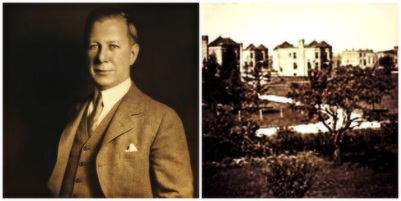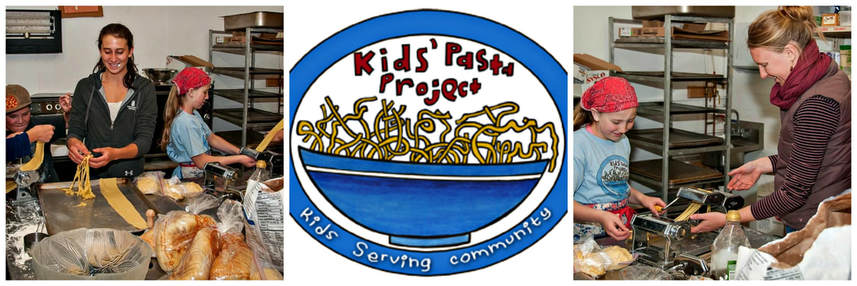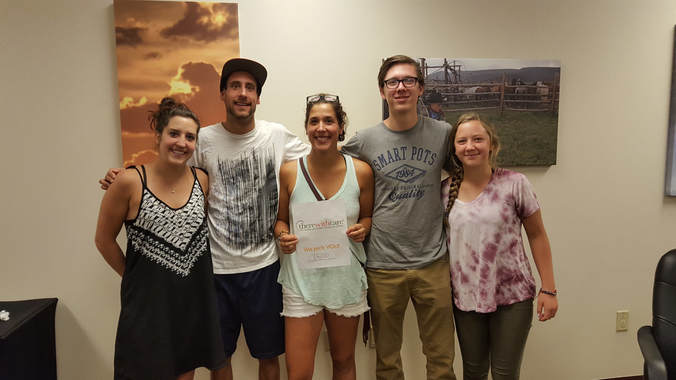|
Learn more about ways to engage your family in philanthropy as we reflect on our youth philanthropy programming. Who is Involved:
History of Youth Engagement: Three years ago, our family foundation came to a dramatic juncture in our organizational lifecycle and purpose. At the time, Moniker Foundation was simple. Scholarships to needy students and grants to organizations close to the Board’s heart. Knowing this philanthropic purpose, the Board set out to learn if they had more road to pave. So, we embarked down the road of strategic planning. Mission, vision, and desired impact were mapped, asked, answered, and evaluated. The most important question the Board had to answer was, “Do we want Moniker to last into perpetuity or should we sunset it?” Moniker became slated for perpetuity. With this pinpointed, we needed to determine how to accomplish this? Two paths formed – work from within the family or hire externally. The Board valued utilizing Moniker as the glue to hold the family together and carry on the family legacy, so we decided to chip away at an internal, family-forward, framework. I am the first paid staff and the first member of the third generation to be involved at a higher level. I was tasked to piece together the Board’s goal of next generation, and greater family, involvement. Our framework came together fulfilling two purposes – intentionality and flexibility. We are concrete and thoughtful in our Scholarship Program and Competitive Grants Program, yet we are flexible in our Family Giving Program. I’d like to reflect on our Family Giving Program, especially our Philanthropy for all Ages Program. It is a tiered approach for ages 6 to 18+. Philanthropy that is simple. Philanthropy that focuses on relationships and experiences. Philanthropy that seeks to spark an intrinsic value so that young family members are eager, excited, and self-selecting their involvement once they become adults. Current Youth Engagement Strategies: Ages 6 -10: Feed the Piggy - Save, Grow, Give Children receive a Moniker piggy bank along with our very own book about philanthropy, The Daring Duo: A Story of Two True Super Heroes. For every $1 saved, Moniker matches $10, up to $500. At the end of the year, the child chooses where they would like to give the money. This is by far my favorite program of Moniker. It’s heart-warming and inspiring. Too often we don’t ask children for their opinion. I have learned that children are smart, observant, and caring. My nephew, Wyatt, decided to donate his first piggy to homeless children. We took Wyatt, with his bag full of shiny coins, to visit Urban Peak – an organization serving just that, homeless youth. Wyatt received a tour of their shelter where the children sleep and eat. He learned about the chores that they complete for points which they can use towards various aspects during their stay. On the ride home, Wyatt pointed to people on the street asking if they were homeless youth. Every time I see him, he asks when he can go visit again. It melts my heart. Advice to Others:
Ages 10-15: Helping Hands Children engage in service-oriented projects. Moniker provides a $500 grant to the organization upon completion of the project. This program focuses on the second “t” in the tried and true philanthropy philosophy - time, talent, and treasures. By this age children have more than enough talents to share! And what’s even better, they know what their talents are and they want to be recognized for them. This age is great for further exploring the world and how one can contribute to it. My cousin Liza lives in a small, rural community in Colorado. Liza, not shy about helping others, volunteered her time with Kids Pasta Project –an organization that prepares and sells freshly-made, healthy meals and in turn gives the profits to local causes. Liza reflected on her experience by sharing, “The program gives us a way to serve our communities and further learn skills like cooking, serving, and hosting. When you get older you get to be a leader by helping each of the younger kids.” Advice to Others:
Ages 10-18: Juniors Juniors is our Junior Board program. Here members learn the components of grant-making by attending site visits, reading proposals, and presenting requests to the Board. Juniors are allocated $5,000 to give to one set of proposed organizations. This selection occurs once per year at our family reunion. The lessons, skills, and values taught in the earlier years are meant to come full circle through this program. It also acts as the mixing pot for the older ages. 10-year-olds have just as much value to bring to the conversation around impact and need as do the older kids. The older kids also get to showcase their leadership styles. Advice to Others:
Ages 18+: Familyship
Family members are eligible for a Board seat and/or a time-designated internship. Now family members are all grown up and ready to take on a real job in the world of philanthropy! From creating spreadsheets to researching feasible programming, the Familyship is built around the foundation’s workflows, family members’ passions, and their allotted time commitment. A few family members have completed this opportunity with Moniker. This program is the most time intensive program for the foundation’s staff as it requires tender love and care. Not only is it a resume-building opportunity for them, but it is a leadership opportunity for staff. Being a small-staffed foundation, we can often get in the mindset of one-man is best. Bringing other people to the table is refreshing, yet at times very challenging, which keeps everyone on their toes! Advice to Others:
Resources to Share Upon Request:
Download the article from the National Center for Family Philanthropy here. In 1929, a young woman by the name of Elizabeth Sage Hare dreamed of a school built on traditions, excellence, and a progressive commitment to academic advancement. This school would not only thrive in the cultural setting of the West, but more importantly it would shape the academic curriculum for youth in preparing them for college.
In 1930, with the help of Colorado Springs entrepreneurs such as Spencer Penrose, the boarding school for boys opened. It wasn’t until 1975 that the school became coeducational. Today, the school serves 240 students from 24 states and 21 countries. It remains a boarding and day school focused on providing a rigorous college-preparatory curriculum in academics, athletics and the arts. The Wicks and the Sintons valued the attention to such commitment to education. Starting in the 1980s, they found their commitment to supporting the institution and a lifetime of academic excellence through annual gifts. Furthermore, they also supported the institution with their involvement in the Casa Serena Society. No matter the size, annual giving is a heartfelt way to support to an organization. Similar to a business earning a profit to further deliver products and services for their customers, nonprofits rely on individual donors and grants from foundations to keep the lights on and services plenty for those in need. To the Sinton family, philanthropy means supporting those who don’t have the means to support themselves. The James J. Sinton Memorial Scholarship Fund does precisely that by helping Business Administration or Economics students obtain financial aid in their pursuit of a post-secondary education at Colorado College (CC). The Fund was initially endowed to CC in 1971 on behalf of Tom Sinton, husband to Bee Sinton, our founder. Both Tom and Bee graduated from CC and thus wanted to give back to their alma mater. Tom also wanted to way to honor and remember his father James Sinton.
With a beginning balance of $163,000, today the Fund has grown to over $1.4 million and has supported 85 students over the years, typically awarding two to four scholarships per year. With the help of investment managers, the Fund will continue to support a student’s dream of becoming the first in their family to graduate with a college degree. Endowments have become a way for individuals or families to pass on their wealth to a nonprofit organization of their choice. They are structured such that the initial principal amount is left intact or untouched and the investment interest can be drawn upon to fulfill the desire of the donor. Most commonly, institutions that manage endowments include museums, libraries, theaters, hospitals, and universities. Endowments, to many, are a way to leave behind a legacy all-encompassing of individual and family values, tradition, and a greater life meaning. To Tom, it was a way to support education, a valued tradition in the family. Bee continues this legacy through her vision of Moniker Foundation and our own Scholarship Program.  Education is a value embedded deep in the roots of our family’s history. Even prior to the formation of The Moniker Foundation, education was a value and focus passed on from one generation to the next. It is no surprise that our founder’s grandfather, Frank England, supported educational organizations such as the then Glenwood School for Boys, today known as the Glenwood Academy. The Glenwood Academy had a rich history in shaping the educational culture that existed in Chicago in the late 1800s. From its early inception in 1877, the founders witnessed an extreme need to help boys who had found themselves in unfortunate situations with the law or their guardianship. Rather than learning solely from a book or standard classroom materials, the school focused on education through skill development and leadership. The founding vision for Glenwood was to turn “child-saving” into “person-building” by transforming dependent children into self-sufficient adults who lived productive lives. The concept of the school was to provide a home and a proper training school for these dependent boys. Glenwood Academy today upholds its founding vision and values. It remains the only boarding school in Illinois; providing children with a variety of ways to discover their talents and interests outside the classroom. The Moniker Foundation upholds a similar vision in regards to our Scholarship Program. Not only do we want to financially assist our Scholars, but furthermore, and more importantly, we hope to instill the values and importance of community stewardship and work experience. We do this by asking our Scholars to complete community service projects as well as evaluate their time spent at school. Learn more about the Program by visiting our Scholarship Program page.  Summary of the 2014-2015 grant requests. Summary of the 2014-2015 grant requests. In 1998, The Moniker Foundation was created as a way to simply give back to the community through supporting worthy organizations and post-secondary students. At this time Moniker was doing, if we were to place a label on it, “checkbook philanthropy.” “Checkbook philanthropy,” while sometimes viewed with a negative connotation, is spontaneous philanthropy – a response to an appeal for funding combined with personal values of what one deems to be a worthy cause. Over the past 17 years, with specific attention to the last three years, Moniker has modified its philanthropic role in serving the community. In our hope to be more intentional, Moniker has made the shift towards “responsive philanthropy.” “Responsive philanthropy” is just that, responsive. Donors and foundations respond to formal requests, typically in a designated focus area. Our focus areas are two-fold - education and/or human services. Moniker’s Structured Giving Program is an ideal representation of “responsive philanthropy,” in that organizations fill out a formal request and these requests are reviewed through a formal grant committee. This year has been the most rewarding year yet in terms of the diversity and location of the requests. As we finalize our review for our 2014-2015 grant recipients, we celebrate 26 requests from 7 different Colorado counties. Out of 64 counties, it may not seem like that much of an expanse, but for our family foundation, for the first time, we get to be more strategic in our grant making. Yet, still being family oriented keeps an interesting dynamic at the table. We still value “checkbook philanthropy” as it provides a way for family members to explore the world of giving back through their own passions and values. Our Family Giving Grants Program supports the other side of the pendulum. Family members have the opportunity to act as the community chest for organizations that need resources more immediately. They also share a piece in the big picture, 30,000 foot view, of Moniker – further cultivating generational interest in the perpetuity of our family foundation. So, while we have picked up the new world of giving back, we still remain tied to our roots. Our hope is to balance “checkbook philanthropy” with “responsive philanthropy” in an attempt to keep our family foundation flexible yet intentional. |
Archives
November 2017
Categories |






 RSS Feed
RSS Feed